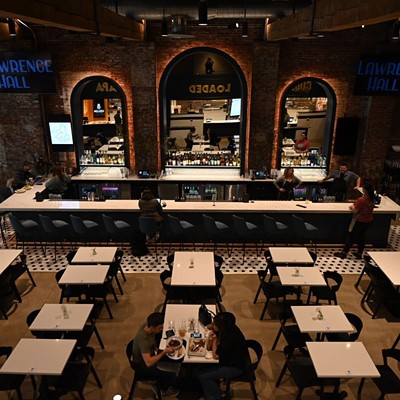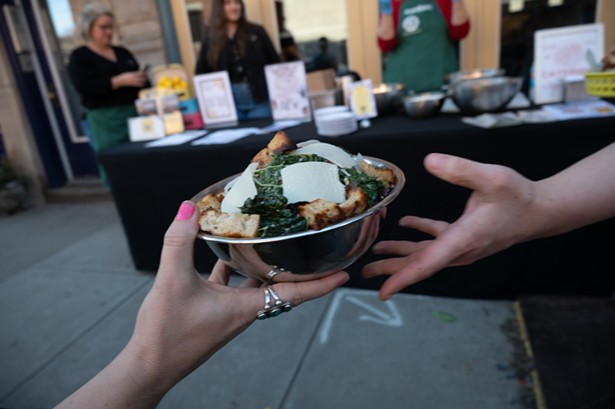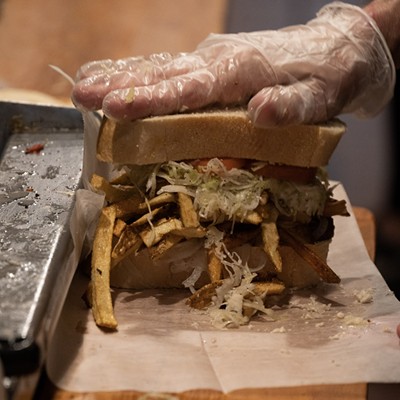The far North Hills (that is, Cranberry and beyond) is developing a strong culinary culture. We've documented the increasing number of excellent dining options in the suburbs for years, and the margins of Butler County have attracted an exceptionally diverse and enticing smorgasbord. Alongside the usual chain restaurants, you'll find a half-dozen suburban outposts of the city's most successful dining spots, plus several locally owned establishments (including a grocery outlet), all providing vigorous competition for North Hills dining dollars.
But of all the cuisines that veteran diners try to reproduce at home, it must be said that Japanese ranks pretty far down the list. Perhaps that's because that best-known of Japanese dishes, sushi, is famously uncooked. Or maybe the average, or even ambitious, American home cook just hasn't yet developed the fluency with Japanese ingredients that he or she has with, say, Thai spices or Italian cheeses. Whatever the reason, it's not lack of appetite for Japanese food, which pretty much guarantees that there's going to be at least one Japanese restaurant in any urbane dining district.
Which brings us to Yama Sushi in (yes) a strip mall in Mars. The restaurant appeared wholly Japanese, and not some amalgam of Asian cuisines. It was a pleasure to peruse Yama's menu and find not a single vaguely Chinese stir-fry or kimchee roll -- just authentically Japanese, and Japanese-American, dishes. Such a thoroughly Japanese menu is not just monocultural, but educational as well; it introduces diners to the true breadth and depth of a cuisine that, for many, has been reduced to raw fish and vinegared rice.
Beef negimaki (beef scallion roll) is an example of a dish that Angelique never encountered while living in Japan, but which frequently appears on American Japanese restaurant menus. Taking on the form of maki sushi, it's thin strips of beef rolled around a small bouquet of scallions and broiled with teriyaki sauce. Yama's version included appropriately tender beef, and the scallions within were crisp and bright. But beyond the savory-sweet sauce, the beef lacked strong flavor. Not a miss, exactly, but not a hit, either.
Spicy ika (squid) salad was far more exciting. And it somehow came across as simple, despite a long ingredient list: Along with the finely chopped squid, there were fish roe, crabstick, cucumber, avocado, seaweed salad and filaments of finely shredded daikon. The vegetables were crisp and tender, the tentacles firm against tender "crabsticks," and the native flavors were mild in a subtly piquant dressing. The dish held some of the characteristics of a good seaweed salad -- varied texture, oceanic flavor -- but with more body and substance.
Perhaps due to a daily oyster special, fried oysters were unavailable, so we switched to a mixed tempura platter. Tempura is, of course, Japan's version of deep-frying, using extra-crispy, airy panko crumbs. When done well, the result is shrimp and vegetables lightly cooked within, and nicely crisp without. Such was Yama's array: Even the juiciest zucchini fried up as crisply as the densest sweet potato.
Yama's sushi selection was much wider than we're accustomed to at any but the best sushi restaurants, with such delicacies as fluke, pickled mackerel and multiple types of tuna. (Also on offer: seldom-seen vegetable sushi, such as pickles, squash and sweet potato.) As a measure of this, the most basic eight-piece nigiri platter included six different fish, plus a classic tuna maki. The rice was moist and flavorful without being heavy or obtrusively seasoned, and every piece of fish was tender and packed with character: smooth fluke, meaty salmon, savory yellowtail, steak-like tuna.
We also ordered a second sushi platter, with a splendid yellowtail scallion maki and a house specialty maki, the kamikaze. House maki rolls tend to feature a few standards (e.g. dynamite rolls, California rolls, overstuffed futomaki), but Yama offers more than a dozen unique, if not always convincing, combinations. The kamikaze roll caught our eye for combining spiciness with mackerel, a fish we enjoy for its balance between mildness and oily fishiness. This roll had half a dozen additional components, and we especially enjoyed the end pieces, which resembled tiny cityscapes of thinly sliced ginger, cucumber, avocado and sprouts alongside the fish.
We also tried one hot entree, yaki udon, fat buckwheat noodles in light broth with, among other things, cooked chicken. It was not exactly chicken soup, but not far off, with comforting, soft (but not mushy) noodles and fine pieces of chicken.
We wish we had more restaurants of Yama Sushi's type close to home: honest, straightforward Japanese cooking without hibachi theatrics, and undiluted by Chinese, Korean or other culinary languages. At Yama Sushi, Japanese is expressive enough.
Yama Sushi
515 Adams Shoppes, Rt. 228, Mars. 724-591-5688
Hours: Mon.-Thu. 11:30 a.m.-10 p.m.; Fri.-Sat 11:30 a.m.-10:30 p.m.; Sun. noon-9 p.m.
Prices: Appetizers, soup, salad and a la carte sushi $2-12; kitchen entrées $9-25; sushi platters $11-26
Liquor: BYOB













